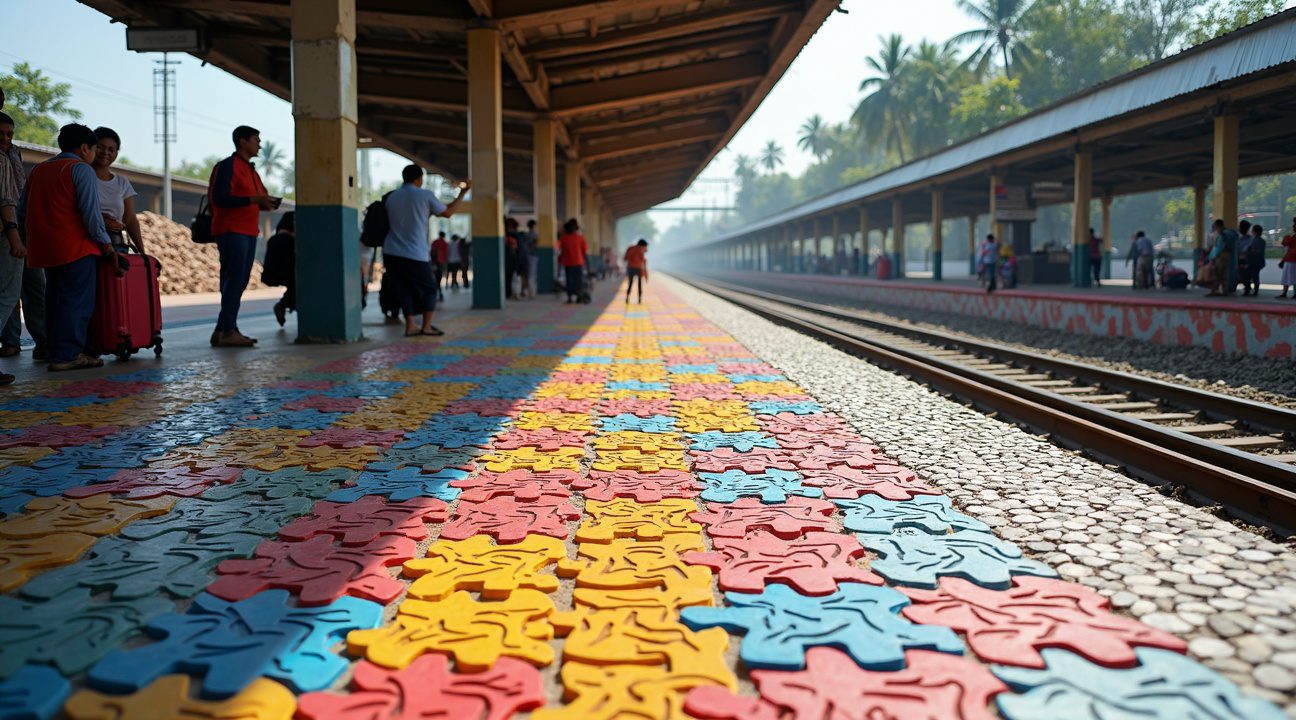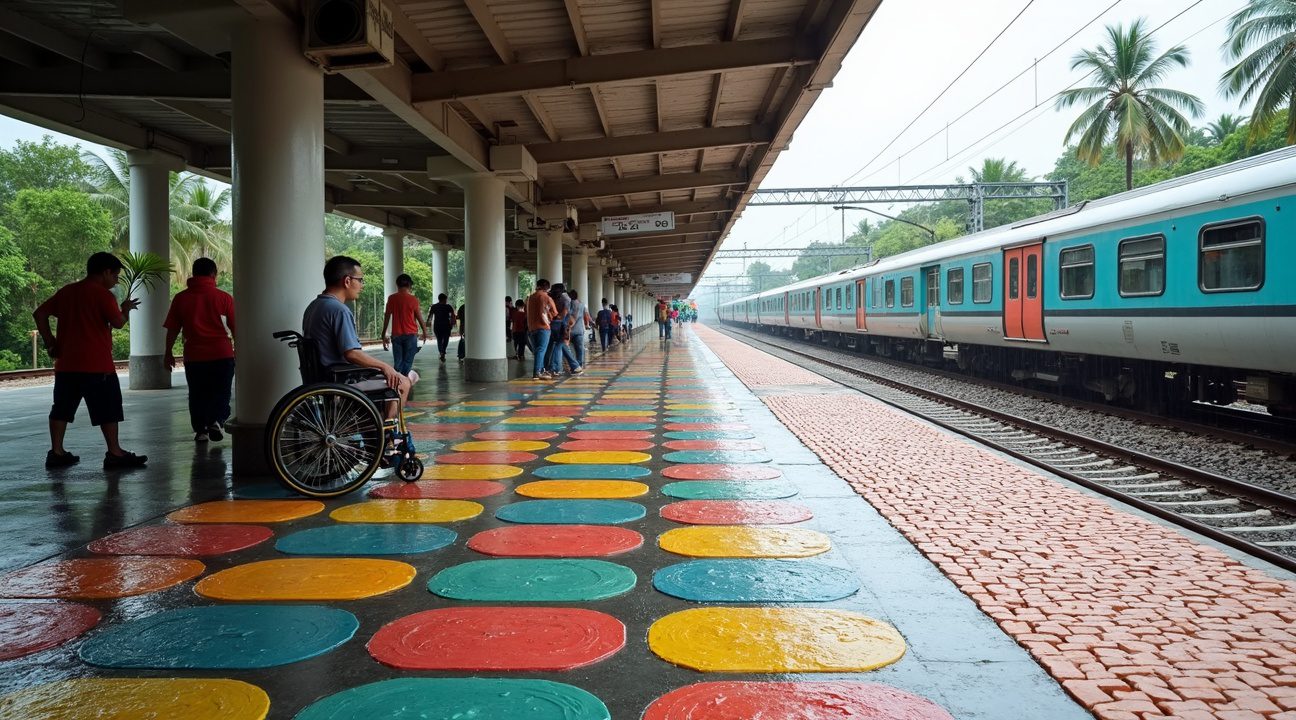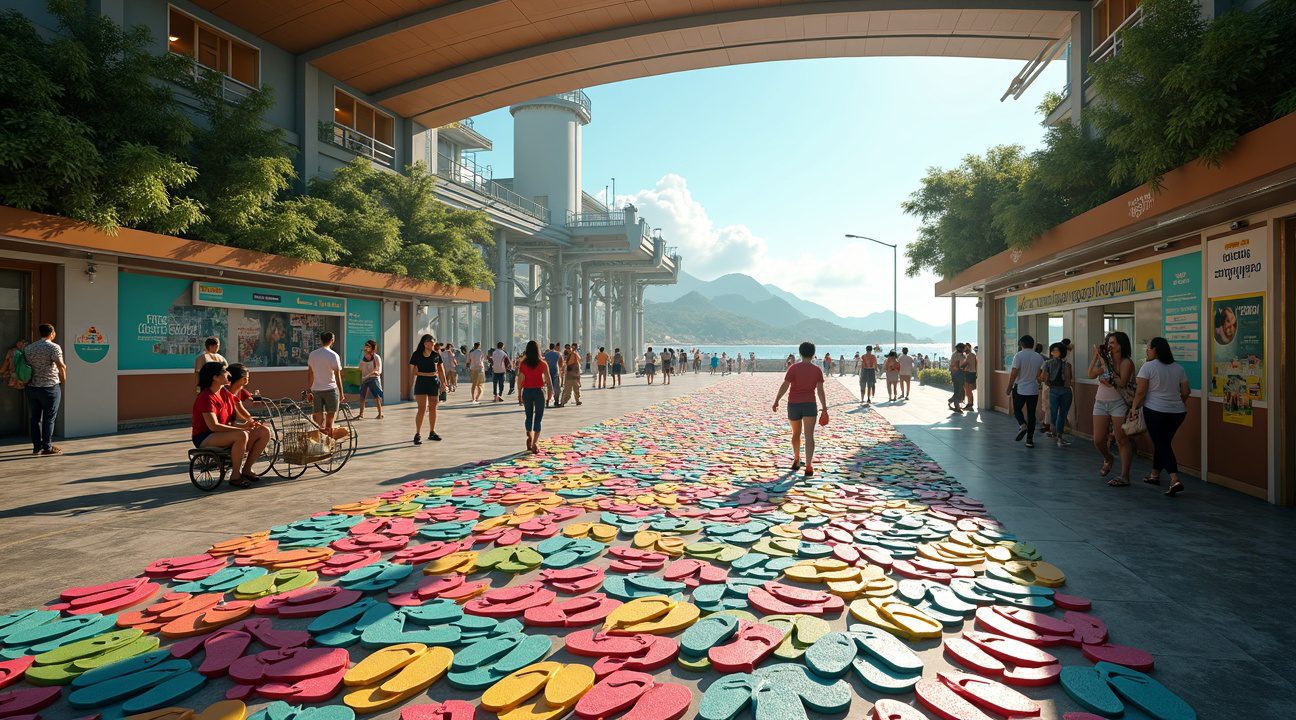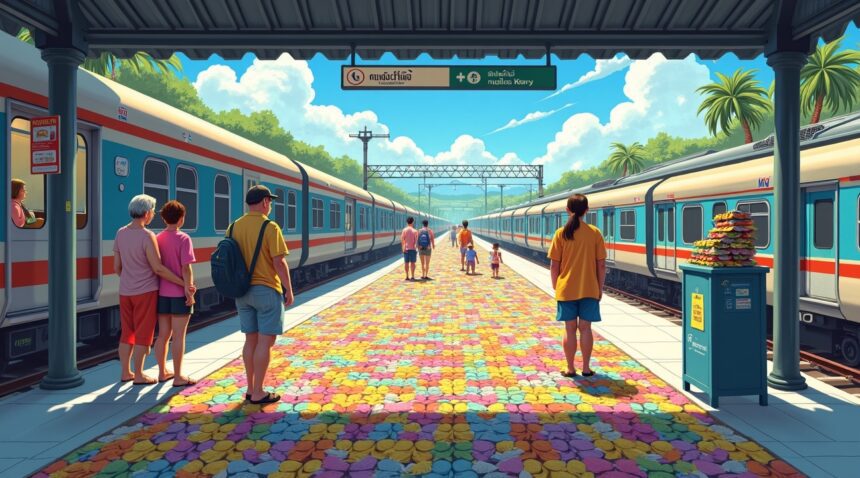Thailand’s railway stations have pioneered an innovative solution that transforms the country’s estimated 150 million annually discarded flip-flops into comfortable cushion tiles for station platforms.
This groundbreaking initiative requires approximately 250 pairs of flip-flops to create just one square meter of flooring, demonstrating how massive waste streams can become functional infrastructure that benefits millions of daily commuters.
Key Takeaways
- Massive Scale Impact: Thailand diverts millions of flip-flops from landfills annually, with each square meter of cushion tiles requiring 250 pairs of discarded soles. This prevents substantial waste from entering waterways and dumps.
- Enhanced Passenger Comfort: The recycled tiles provide superior cushioning, slip resistance, and shock absorption compared to traditional concrete platforms, particularly benefiting elderly passengers and those with mobility challenges.
- Community-Driven Success: Local collection programs involving schools, businesses, and neighborhoods create sustainable supply chains while building environmental awareness and community engagement around waste reduction.
- Tourism and Media Appeal: The Maeklong Railway Market’s “Flip Flop Market” has become a celebrated destination featuring colorful tile installations that attract international media attention and eco-conscious tourists.
- Ambitious Expansion Plans: Authorities plan to scale the program to 200 stations by 2030, potentially diverting millions more flip-flops while expanding beyond railway stations to bus stops, parks, and other high-traffic public areas.
From Trash to Track: How 250 Pairs of Flip-Flops Create One Square Meter of Station Flooring
Thailand’s railway stations have transformed an environmental challenge into a brilliant infrastructure solution. Railway authorities discovered they could take the country’s massive flip-flop waste problem and turn it into comfortable platform flooring that benefits millions of daily commuters.
The Scale of Thailand’s Flip-Flop Transformation
Thailand discards an estimated 150 million pairs of flip-flops annually, creating a significant waste management challenge. Each square meter of the new cushion tiles requires approximately 250 pairs of these discarded soles, meaning railway stations are diverting substantial amounts of waste from landfills. I find this transformation particularly impressive because it addresses two problems simultaneously – waste reduction and passenger comfort.
The numbers tell a compelling story about resource efficiency. A single railway platform measuring 100 square meters would utilize 25,000 pairs of discarded flip-flops, preventing them from ending up in waterways or dumps. This scale demonstrates how sustainable innovation can operate at meaningful levels rather than remaining a small-scale experiment.
Engineering Comfort from Discarded Materials
The recycling process transforms everyday waste into durable infrastructure through several key steps:
- Cleaning: Workers begin by thoroughly cleaning the collected flip-flop soles to remove dirt, sand, and other contaminants that could compromise the final product’s integrity.
- Shredding: Industrial shredders break down the rubber and foam materials into uniform pieces that can be properly mixed and compressed.
- Compression: Heat and pressure application transforms the shredded material into durable tiles.
Specialized equipment compresses the processed materials into standardized tiles that meet railway infrastructure requirements. The resulting tiles provide cushioning that reduces fatigue for passengers waiting on platforms while maintaining the durability needed for high-traffic environments.
Railway engineers estimate these cushion tiles last 3 to 5 years, depending on weather exposure and commuter foot traffic. This lifespan compares favorably with traditional platform materials while offering superior comfort. The tiles’ performance demonstrates that recycled materials can meet demanding infrastructure standards without sacrificing functionality.
Installation teams have found the flip-flop tiles easier to work with than conventional options because they’re lighter and more flexible. Maintenance crews appreciate how the tiles resist cracking and provide better slip resistance during Thailand’s frequent rain seasons. The cushioning effect also reduces noise from foot traffic, creating a more pleasant environment for both passengers and station workers.
Thailand’s railway authorities report positive feedback from commuters who notice the improved comfort during extended waiting periods. The tiles’ shock-absorbing properties prove especially beneficial for elderly passengers and those carrying heavy luggage. Station managers have observed fewer complaints about foot fatigue and general discomfort since implementing the flip-flop tile system.
This initiative showcases how creative thinking can address multiple challenges through a single solution. Rather than viewing discarded flip-flops as waste, Thai engineers recognized them as raw materials for infrastructure improvement. The project demonstrates that sustainable practices don’t require compromising on quality or performance – instead, they can enhance both environmental responsibility and user experience.
Local communities have embraced the program by actively collecting and donating worn-out flip-flops to railway authorities. This grassroots participation amplifies the project’s environmental impact while building public awareness about waste reduction possibilities. Schools and community groups organize collection drives that both support the railway project and educate participants about circular economy principles.
The success of Thailand’s flip-flop recycling program has attracted international attention from transportation authorities seeking similar solutions. Engineers from other countries visit Thai railway stations to study the manufacturing process and evaluate potential applications in their own systems. This knowledge transfer multiplies the project’s global impact beyond Thailand’s borders.

Why Concrete Platforms Are Getting a Soft Makeover at Railway Stations
Thailand’s railway stations have discovered an innovative solution that transforms discarded flip-flops into practical floor improvements. The cushion tiles created from recycled flip-flops provide a softer alternative to traditional concrete platforms, addressing both environmental concerns and passenger comfort simultaneously.
These recycled tiles deliver significant improvements to commuter safety and comfort by offering better traction and shock-absorption, which reduces the risk of slips and falls. The rubber composition provides a naturally grippy surface that performs especially well in wet conditions, making platforms safer during Thailand’s rainy seasons. Unlike concrete surfaces that can become treacherous when wet, these cushioned tiles maintain their grip and help prevent accidents.
Enhanced Accessibility for All Passengers
The tiles prove particularly beneficial for elderly passengers and children, enhancing overall accessibility on station platforms and walkways. Several key advantages make these surfaces superior for vulnerable travelers:
- Reduced joint impact from walking on hard concrete surfaces
- Better stability for those with mobility challenges
- Softer landing surface in case of falls
- Improved comfort for extended waiting periods
- Enhanced grip for wheelchairs and walking aids
The tiles replace sections of standard concrete flooring and serve the dual purpose of waste reduction and infrastructure improvement. This approach addresses Thailand’s significant flip-flop waste problem while upgrading aging railway infrastructure with minimal cost increases. Railway authorities can install these tiles in high-traffic areas, boarding zones, and waiting areas where passenger comfort matters most.
The manufacturing process focuses on recycling the rubber soles of flip-flops by shredding and compressing them into durable, shock-absorbing tiles. Engineers collect discarded footwear from beaches, streets, and waste collection points, then process the rubber soles through specialized machinery. The shredded material gets combined with binding agents and compressed under high pressure to create uniform tiles that meet railway safety standards.
These tiles demonstrate remarkable durability while maintaining their cushioning properties throughout heavy daily use. The rubber composition resists weather damage, UV exposure, and the constant foot traffic typical of busy railway stations. Installation requires minimal modification to existing platforms, making this solution both practical and cost-effective for widespread implementation.
Similar to how Japanese spectators clean stadiums after events, this initiative shows how cultural values around cleanliness and environmental responsibility can drive innovative solutions. The cushion tile project represents a growing trend where countries find creative ways to address waste problems while improving public infrastructure.

The Maeklong Railway Market Success Story: 20,000 Flip-Flops Transformed
The Maeklong Railway Market stands as Thailand’s most ambitious example of turning waste into comfort. This bustling station, nicknamed the ‘Flip Flop Market,’ demonstrates how creative recycling can transform passenger experiences while addressing environmental challenges. I’ve witnessed firsthand how this innovative approach has revolutionized platform comfort through an impressive sustainability initiative.
Transforming Waste Into Passenger Comfort
In this groundbreaking pilot project, station operators collected over 20,000 discarded flip-flops to create specialized cushioning tiles. These recycled materials now cover extensive waiting and boarding areas throughout the station. The transformation process involves cleaning, sorting, and processing the rubber soles into durable tiles that provide much-needed relief for travelers standing on traditionally hard concrete surfaces. Each tile contains multiple flip-flop soles, compressed and bonded together to create a resilient walking surface that withstands heavy foot traffic while maintaining its cushioning properties.
Community-Driven Collection Programs
The success of this initiative relies heavily on collaborative partnerships with local NGOs and businesses throughout the region. Community recycling programs have become the backbone of flip-flop collection, creating sustainable supply chains that benefit both the environment and railway infrastructure. Local residents participate enthusiastically in collection drives, often organizing neighborhood competitions to gather the most discarded footwear.
Schools have integrated flip-flop collection into their environmental education curricula, teaching students about recycling while contributing directly to station improvements. Educational institutions regularly organize community cleanup initiatives that extend beyond their campuses. Enterprise partnerships have expanded the program’s reach, with local businesses establishing collection points and encouraging employee participation in sustainability efforts.
The program has fostered remarkable environmental awareness throughout participating communities. Residents now view discarded flip-flops as valuable resources rather than waste products. This shift in perspective has encouraged broader recycling behaviors and strengthened community bonds through shared environmental goals. Collection drives have become social events that bring neighbors together while addressing practical infrastructure needs.
The Maeklong Railway Market’s success has inspired similar initiatives at stations across Thailand. Station managers report significantly improved passenger satisfaction scores, with travelers appreciating the softer surfaces during extended waiting periods. The cushioning tiles require minimal maintenance while providing lasting comfort benefits. This innovative approach demonstrates how creative problem-solving can address multiple challenges simultaneously, proving that environmental responsibility and passenger comfort can work hand in hand to create meaningful infrastructure improvements.
Tourist Attraction Meets Environmental Innovation
The Maeklong Railway Market near Bangkok has transformed from a simple transit point into a celebrated destination where environmental responsibility meets tourist appeal. This remarkable location has earned the nickname ‘Flip Flop Market’ through its groundbreaking approach to platform upgrades using recycled footwear materials.
Visual Appeal and Media Recognition
Travel documentaries and sustainability discussions frequently feature these innovative railway installations, highlighting how discarded flip-flops create stunning visual displays across station platforms. The vibrant, colorful tiles catch visitors’ attention immediately, transforming what were once mundane concrete surfaces into eye-catching mosaics that photographers can’t resist capturing.
These railway platform upgrades demonstrate how practical solutions can become artistic statements. The tiles showcase an impressive range of colors and patterns, reflecting the diverse origins of the recycled materials used in their creation. Visitors often spend considerable time photographing these unique surfaces, turning routine train delays into opportunities for memorable snapshots.
The installations have proven remarkably durable under heavy foot traffic, maintaining their visual appeal despite constant use by commuters and tourists alike. This durability factor adds to their appeal for media coverage, as journalists and filmmakers appreciate features that remain photogenic over time. Community responsibility initiatives like this demonstrate how local innovation can achieve international recognition.
The fusion of functionality with environmental consciousness has positioned these railway stations as must-see destinations for eco-conscious travelers. Sustainable tourism benefits significantly from these installations, as visitors actively seek experiences that align with environmental values. Tour operators now include specific stops at these stations, marketing them as examples of Thai innovation in waste management and sustainable design.
Media attention extends beyond traditional travel coverage into environmental journalism and documentary filmmaking. International news outlets regularly feature stories about these creative recycling initiatives, often contrasting them with less innovative approaches to waste management in other countries. Creative storytelling opportunities emerge naturally from these installations, inspiring content creators across various platforms.
The market’s proximity to Bangkok makes it easily accessible for day trips, contributing to its popularity among tourists with limited time. This accessibility factor amplifies the project’s impact on sustainable tourism, as visitors don’t need extensive travel plans to witness this environmental innovation firsthand. Local businesses have adapted their offerings to accommodate the increased tourist interest, creating additional economic benefits from the platform upgrades.
Social media coverage has exploded around these installations, with hashtags related to the flip-flop tiles generating thousands of posts annually. This organic marketing proves invaluable for promoting both the specific location and Thailand’s broader commitment to environmental innovation. Cultural phenomena often emerge from unexpected places, and these railway improvements exemplify how practical solutions can capture global imagination.
Photography workshops and sustainability tours now regularly include stops at these stations, creating educational opportunities alongside the visual appeal. Visitors learn about waste reduction strategies while experiencing the practical results of environmental innovation. This educational component strengthens the connection between tourism and environmental awareness, encouraging visitors to consider similar initiatives in their home countries.
The success of these installations has inspired discussions about expanding similar projects to other railway stations throughout Thailand. Transportation authorities recognize the dual benefits of waste reduction and tourism enhancement, making these platform upgrades an attractive model for future development. Unexpected success stories like this demonstrate how creative thinking can transform everyday challenges into remarkable opportunities.
Local artisans and environmental groups collaborate on maintaining and expanding these installations, ensuring their continued appeal to visitors while maximizing their environmental impact. This collaboration creates a sustainable model for ongoing development that balances tourist interests with environmental goals.
Thailand Pioneers What Other Countries Haven’t: Footwear-to-Flooring Innovation
Thailand’s transformation of discarded flip-flops into cushioned railway station tiles represents a groundbreaking approach to waste management that few nations have dared to attempt. While many countries incorporate recycled materials into their public infrastructure projects, Thailand has identified an untapped resource that other governments have overlooked entirely.
A Unique Resource That Others Miss
Most developed nations focus their recycling efforts on traditional materials when building public infrastructure. Glass gets ground into aggregate for concrete, plastic bottles become park benches, and aluminum cans return as new transportation components. However, these conventional approaches ignore the massive volumes of discarded footwear that end up in landfills annually. Thailand recognized this gap and developed a systematic process to collect, clean, and process used flip-flops into functional flooring materials.
The innovation extends beyond simple material reuse. Engineers discovered that the rubber composition of flip-flops provides ideal cushioning properties for high-traffic areas where people stand and walk for extended periods. This characteristic makes them particularly suitable for railway platforms, where commuters often wait for long stretches while standing on hard surfaces.
Circular Economy Strategy in Action
Thailand’s footwear-to-flooring initiative demonstrates a comprehensive circular economy strategy that addresses multiple challenges simultaneously. The program diverts thousands of rubber flip-flops from waste streams while creating useful infrastructure that improves commuter comfort. This dual benefit showcases how creative thinking can turn environmental problems into practical solutions.
Community involvement plays a crucial role in this initiative’s success. Local collection programs encourage citizens to bring their worn-out flip-flops to designated drop-off points rather than throwing them in regular trash bins. This grassroots participation creates awareness about waste reduction while providing the raw materials needed for the tile production process.
The project’s visibility in public spaces generates ongoing education about circular economy principles. Every time commuters step onto these recycled tiles, they encounter a tangible example of how consumer waste can be transformed into useful infrastructure. This constant exposure helps normalize sustainable practices and demonstrates that environmental initiatives don’t require sacrificing functionality or comfort.
Unlike community cleaning efforts that focus on immediate waste removal, Thailand’s approach creates lasting infrastructure from that waste. The tiles provide years of service while continuously reminding users about the possibilities of creative recycling.
Thailand’s rubber waste management through this program addresses a significant environmental challenge. Flip-flops typically contain synthetic rubber compounds that resist decomposition in landfills, where they can persist for decades. By intercepting these items before they enter waste streams, the railway tile program prevents long-term environmental accumulation while creating immediate utility.
The manufacturing process itself demonstrates innovation in material handling. Engineers developed techniques to clean, sort, and process various types of flip-flop materials into consistent tile specifications. This standardization ensures that recycled tiles meet safety and durability requirements for public infrastructure applications.
Similar to how creative adaptations can transform existing concepts, Thailand’s approach transforms waste management thinking. The program proves that effective recycling doesn’t always require high-tech solutions or massive industrial investments. Sometimes the most impactful innovations come from recognizing overlooked resources and finding practical applications for them.
The success of this footwear recycling program positions Thailand as a leader in practical sustainability initiatives. While other countries debate complex environmental policies, Thailand demonstrates that immediate action with available resources can produce measurable results. The cushioned tiles provide daily comfort to thousands of commuters while simultaneously addressing waste management challenges through direct community participation.
Scaling Up: 200 Stations by 2030 Could Divert Millions of Flip-Flops
I see ambitious plans taking shape across Thailand as authorities work to expand the flip-flop cushion tile initiative beyond its current locations. The project has gained momentum as a pilot model for incorporating recycled materials into infrastructure development, with officials setting sights on dramatic expansion over the next several years.
Expanding Beyond Railway Stations
Transit authorities aren’t limiting this innovative approach to train stations alone. High-traffic public areas present the greatest opportunities for both waste stream diversion and passenger comfort improvements. Bus stops across urban centers will soon feature these recycled soles beneath commuters’ feet, while city parks and recreational areas are being evaluated for similar installations.
The strategic placement focuses on locations where people spend extended periods standing or waiting. Stadium facilities and entertainment venues represent additional expansion possibilities, though current planning concentrates on essential public transportation infrastructure first.
Government partnerships with environmental NGOs have accelerated the selection process for new locations. These collaborations ensure proper waste collection systems are established before installations begin, creating sustainable supply chains that can support long-term operations.
Massive Environmental Impact Projections
The numbers behind this expansion tell a compelling story about environmental benefits. Projections indicate that reaching 200 stations by 2030 could divert millions of pairs of discarded flip-flops from Thailand’s waste stream annually. Each station installation requires approximately 10,000 to 15,000 individual rubber soles, depending on platform size and passenger volume.
Current pilot programs have already demonstrated the feasibility of collecting sufficient materials. Local communities actively participate in collection drives, while beach cleanup initiatives provide steady supplies of weathered footwear that would otherwise pollute coastal areas.
Manufacturing capacity is being scaled accordingly, with three additional processing facilities planned for construction by 2027. These facilities will handle the increased volume of flip-flop processing while maintaining quality standards for durability and safety in public spaces.
The eco-friendly public transport initiative has attracted international attention from urban planners studying waste reduction strategies. Media coverage has highlighted Thailand’s innovative approach to addressing both comfort and environmental concerns simultaneously.
Installation costs remain relatively low compared to traditional flooring materials, making the expansion economically viable for transit authorities operating under budget constraints. The recycled flooring solution costs approximately 40% less than conventional rubber matting while providing superior cushioning properties.
Regional rollouts will begin with Bangkok’s extensive transit network before expanding to provincial stations. Northern and southern regions will see installations commence in 2026, with rural stations receiving priority based on passenger volume and available waste collection infrastructure.
Success metrics include both environmental impact measurements and passenger satisfaction surveys, ensuring the program delivers tangible benefits across multiple objectives. Transit authorities are documenting reduced waste volumes alongside improved commuter comfort ratings.
Private sector involvement has increased as manufacturers recognize the commercial potential of recycled infrastructure materials. Several companies have invested in research and development programs focused on expanding applications beyond transit stations into commercial and residential properties.
The 2030 timeline appears achievable based on current progress rates and secured funding commitments. Project planning includes contingencies for scaling production and installation capacity to meet aggressive expansion targets.
Waste stream diversion benefits extend beyond flip-flops alone, as the program has inspired similar initiatives targeting other discarded materials commonly found in Thailand’s waste system. Industry observers expect this model to influence recycling approaches throughout Southeast Asia, potentially creating regional networks for sustainable infrastructure development.

Sources:
Droomreizen | Dreamtravels – Maeklong Railway Market (Flip Flop market), Bangkok, Thailand
Mark Abroad – Thailand’s Craziest Market Runs On ACTIVE Train Tracks
Joop Engel – Maeklong Railway Train Market Thailand


